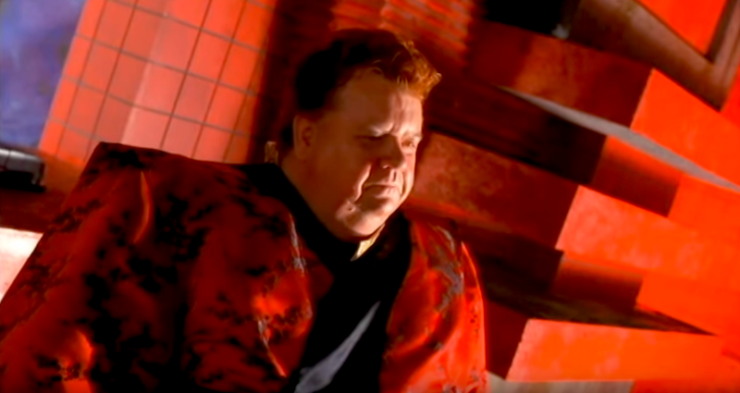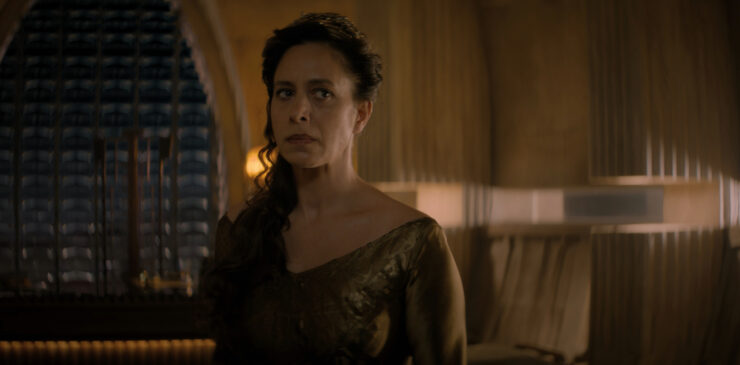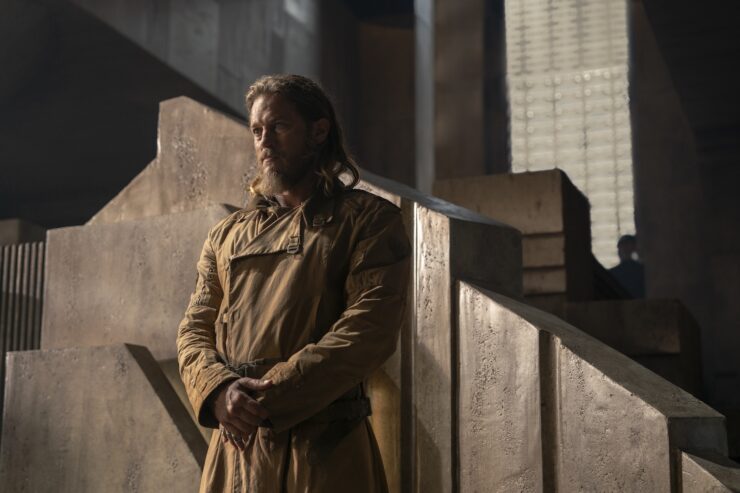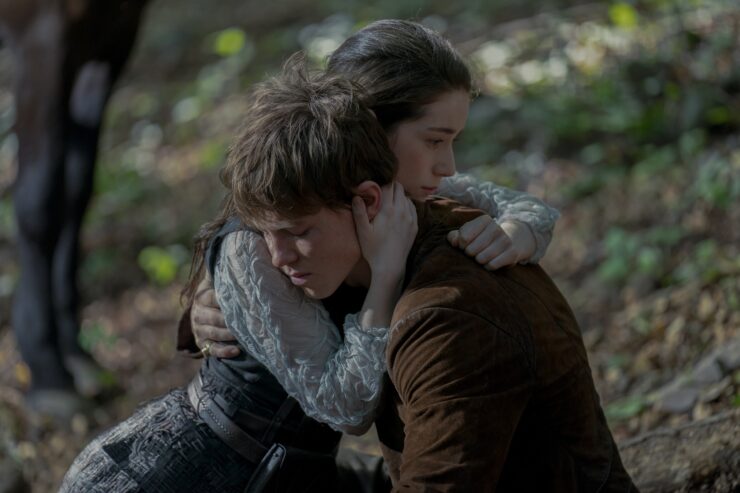As Denis Villeneuve’s Dune beings to take shape, I find myself with all sorts of questions. Can they condense such a complex novel into one or two films and do it justice? Will they change too many core themes, making the story unrecognizable? Where will all that hefty exposition come from? But upon hearing the casting of Stellan Skarsgård in the role of Baron Harkonnen, those questions rapidly filtered down to one:
Is this going to work?
Stellan Skarsgård is an excellent choice to play the Baron in terms of talent, but that’s not really what I’m getting at here. Frank Herbert’s Dune was written in the 1960s when certain types of coding were common for villainous characters. In the case of the Baron, there are two primary issues at hand, two characteristics that further argue his odiousness on the story’s behalf that are rightly seen as contentious today: the Baron is obese, and he is also queer.
In the history of Dune on screen, two different actors have portrayed Baron Vladimir Harkonnen: Ian McNeice in the 2000 Sci-Fi Channel miniseries, and Kenneth McMillan in David Lynch’s 1984 cult film. Lynch’s attempt is infamous for really leaning on those codified aspects of the Baron, to the point where the his sore-ridden appearance has been called out as a likely connection to the AIDs epidemic, which was a prevalent health crisis while the film was in production. Lynch also makes a point of connecting the Baron’s desire for men to deviancy and violence, deliberately juxtaposing his assault of a young man with a tender love scene between Duke Leto and Lady Jessica Atreides (who are the parents of the story’s “hero” Paul Atreides). Ian McNeice’s turn played down these aspects—his appearance was not altered to make him seem ill, he never physically attacks anyone, and the miniseries paid more attention to the fact that the baron was a rapist, his preference for men being incidental.
There have been attempts to explain this away within the narrative and recodify these choices—while Dune itself suggests that the Baron’s obesity might be the result of a genetic disease, Prelude to Dune, a prequel written by Brian Herbert and Kevin J. Anderson retcons this idea and instead posits that the Baron Harkonnen was once a very fit and vain young man. He is given a disease by Reverend Mother Gaius Helen Mohaim after he drugs and rapes her in response to a Bene Gesserit sexual blackmail plot. With that retelling, the Baron’s corpulence is meant to be comeuppance for doing something reprehensible, a physical punishment meant to hurt his vanity by taking away the attractiveness he so prized in himself. Unfortunately, it does nothing to alleviate the connection being drawn between weight and hedonistic sadism, and this explanation isn’t present within the first book at all.
And so, the Baron Harkonnen being the only fat and only visibly queer person in the novel continues to be a problem for Dune. When a villain is the sole character to occupy certain characteristics, the reader or viewer is made keenly aware that those characteristics are being tied to their moral vacancy. Many evil characters in fiction are portrayed as fat (Vernon and Dudley Dursley in the Harry Potter series, The Trunchbull in Matilda, Dennis Nedry in Jurassic Park, etc.), just as many are portrayed as gay or queer (Zed in Pulp Fiction, Buffalo Bill in Silence of the Lambs, Pavi Largo in Repo! The Genetic Opera, and so on). But there’s no reason that a new Dune film has to uphold those choices and keep reiterating those damaging tropes.
The physical appearance of the Baron is particularly noticeable in part because nearly everyone else in Dune is commonly portrayed as lithe and athletic (with the exception of the Baron’s elder nephew, the “Beast” Rabban). But there’s no reason that this has to be the case, and also no reason that the Baron must maintain such a specific silhouette. So how might Villeneuve’s film handle the physical appearance of Baron Harkonnen, as portrayed by Stellan Skarsgård? Outside of allowing the actor to play the role as he is, there are three likely options: (1) he gains weight to plays the role; (2) he wears a “fat suit” to play the role; or (3) his appearance is modified through CGI. All of these choices present potential problems, and it would be a major step forward if the film found a different way to highlight the Baron’s obsession with excess. There’s also his iconic suspensor belt to account for, a device that helps the Baron to walk due to his size, but the film could easily make this an affectation of laziness rather than a physical necessity. He is a powerful man, and is accustomed to having others do for him—the suspensor belt is an extension of that expectation. With that in mind, Baron Harkonnen needn’t be obese for the sole purpose of making misguided points.
As always, the issue with the Baron Harkonnen being the only openly queer character in Dune can be solved the way this problem can always be solved when creating an adaptation: by making it clear that there are other queer people in this universe. (And I don’t just mean the other Harkonnens, who are often queer-coded as well.) In effect, none of the characters in Dune have to be straight, so this is an easy problem to tackle. There are themes that turn on the issues of power in families where there are both spouses and concubines, and families that contain more than one wife—and so could easily contain more than one husband, too. This doesn’t throw off the gender politics of the story whatsoever because breeding remains a paramount issue in Dune regardless. The Bene Gesserit still must plot to bring about the Kwisatz Haderach.
It would be simple to show queer people among the Fremen of Arrakis, or the royal court’s intrigue, or the Bene Gesserit sisters. It would be unsurprising to learn that one of Duke Leto’s painfully loyal men harbored feelings toward him. (I’m not saying it’s Gurney Halleck, but I’m definitely saying that.) Queer people are everywhere, and should fit seamlessly into any narrative. Once that is done, then the fact that the Baron is queer is no longer a signal of a lack of morality. It becomes a fact about him, and nothing more, and narrative is no longer equating queerness with evil.
When you don’t shy away from these potential fixes, you avoid lazy pitfalls that undermine the messages that Dune is trying to convey. Then the story can focus on what makes the Baron truly monstrous—the fact that he spends all of his time plotting murder, sowing discord, and destroying populations of people to get his way—which in turn will make him a far more frightening opponent. By refusing to rely on outdated and hurtful tropes, Dune only comes out stronger.
Emmet Asher-Perrin is very intrigued about the casting for Dune overall, of course. You can bug him on Twitter, and read more of her work here and elsewhere.














